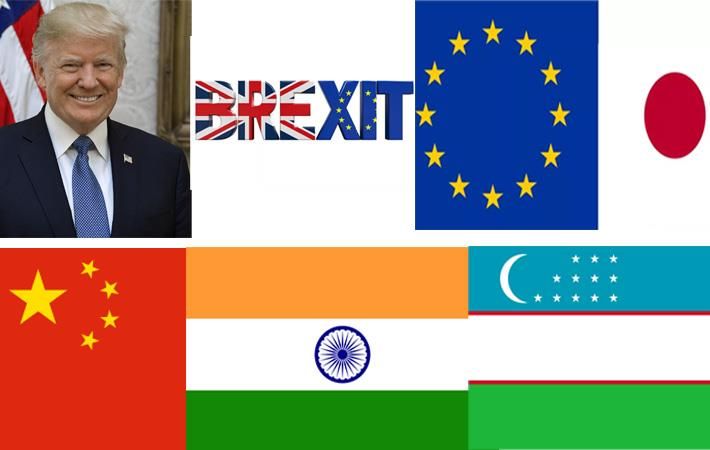Interviews
2018: A Happening Year for Textiles-Apparel
29 Dec '18
8 min read

For global trade and industry, particularly textiles and apparel, 2018 turned out to be a very happening year. Rajesh Kumar Shah looks at top ten developments that changed or is likely to affect global textiles-apparel production and trade.
#1 US: Trump’s Decisions
United States (US) President Donald Trump’s decision of imposing duties on goods of other countries with which it has a negative trade balance, undoubtedly, had the maximum impact on the textiles and apparel industry worldwide in 2018. The US decision forced many textiles and apparel exporting nations to rethink, and be ready with an alternative strategy in case their exports to the US dwindle. As experts focused on pros and cons, especially the US-China trade war, some nations like Bangladesh and Vietnam saw in it an opportunity to boost their exports to the US. The year also saw the US signing a revised free trade agreement with South Korea as also the United States-Mexico-Canada Agreement (USMCA), a rechristened version of the North American Free Trade Agreement (NAFTA).
#2 UK: Brexit Uncertainty
Throughout the year, Brexit remained a point of discussion, over whether common rates would apply for goods entering the European Union (EU) and the United Kingdom (UK) or not. In November, 27 members of the EU approved the British withdrawal and future ties, insisting that it is the "best and only deal possible," paving the way for an "orderly withdrawal." However, the year ended inconclusively on the issue, as the British Parliament is yet to ratify the deal concluded by Prime Minister Theresa May with the EU. The International Monetary Fund (IMF) and Moody’s have warned that a no-deal Brexit would entail substantial costs for the UK. The Bank of England (BoE) has said that the UK may suffer an even bigger hit to its economy than during the global financial crisis 10 years ago if it leaves the EU in a worst-case Brexit scenario.
#3 EU-Japan EPA
The signing of the Economic Partnership Agreement (EPA) by the EU and Japan has made textiles and fashion companies in both EU member nations and Japan be prepared to export more goods. The EPA will create an open trading zone covering 635 million people and almost one-third of the world’s total gross domestic product (GDP) and remove tariffs on industrial products in sectors where the EU is very competitive, such as chemicals, textiles and clothing. Once implemented from February 2019, the EPA—the biggest ever trade agreement negotiated by the EU—will remove the vast majority of the €1 billion of duties paid annually by EU companies exporting to Japan, and will increase EU export opportunities in a range of other sectors, including textiles and clothing.
#4 China: Opening Up
Expanding the opening up of its economy, the Chinese government, effective July 1, 2018, reduced average tariff rate for clothing, shoes and hats, and sports and fitness supplies from 15.9 per cent to 7.1 per cent. It also cut import tariffs on goods from India, South Korea, Bangladesh, the Laos and Sri Lanka from July 1, under the Second Amendment of the Asia-Pacific Trade Agreement. This was followed by a further cut in import tariffs from November 1. For textiles, the average tariff rate was brought down from 11.5 per cent to 8.4 per cent, giving a chance for the global textiles and apparel industry to compete with local manufacturers in the Chinese domestic market. Further, rules for retail imports through cross-border e-commerce are to be relaxed from January 2019.
#5 CPTPP: Takes Effect
The year saw the signing of the Comprehensive and Progressive Agreement for Trans-Pacific Partnership (CPTPP), and the coming into effect from December 30, after being ratified by six countries—the threshold to bring it into force. The CPTPP, the successor to the Trans-Pacific Partnership (TPP) after the US withdrawal, has eleven economies—Australia, Brunei, Canada, Chile, Japan, Malaysia, Mexico, New Zealand, Peru, Singapore and Vietnam—representing around 16 per cent of global economic output and 500 million people. The CPTPP includes reduction in tariff and non-tariff barriers among members with high standards on human rights, labour and environment. The agreement resulted in fresh investment in the textiles and apparel sector in member countries like Vietnam, which is expecting the creation of 17,000-27,000 jobs each year for Vietnamese workers from 2020.
#6 India: Government Support
The Indian government took a number of steps to boost the country’s textiles and apparel industry. It approved 100 per cent foreign direct investment (FDI) under the automatic route for single brand retail trading (SBRT), a Scheme for Capacity Building in Textile Sector (SCBTS) with an outlay of Rs1,300 crore till 2019-20, and Samarth scheme for training 10 lakh people in the textiles industry. It also increased basic customs duty on 76 textiles and apparel products at 6-digit level from mid-July, and followed it up by doubling of import duty on 328 textile products to 20 per cent from the earlier 10 per cent. Duty drawback rates were marginally decreased on several textile items, though they were marginally raised on apparel items with effect from December 19. Overall, these steps have resulted in bringing optimism and new vigour in the country’s textile and garment industry.
#7 AfCFTA: Africa Rising
In what is expected to become the largest free trade area across the globe, 49 African nations signed the African Continental Free Trade Area (AfCFTA). It will create an integrated market of over a billion people in Africa with a combined GDP of nearly $3.3 trillion. AfCFTA will offer opportunities of scale and the free movement of people, goods and services. The United Nations Economic Commission for Africa estimates that the AfCFTA will increase intra-Africa trade from the current 10-16 per cent to nearly 52 per cent by 2022. Among African countries, Ethiopia stood out by setting up industrial parks in Addis Ababa, Hawassa, Mekelle, Adama, and Humera, and attracting investments from Chinese, Italian and Indian textiles and apparel companies.
#8 Asia: Wage Hikes
Apparel exporting countries like Bangladesh, Cambodia and Myanmar witnessed a rise in minimum wage, increasing the cost of production in these countries. In Bangladesh, the second-largest garment exporter after China, minimum wage increased from Tk5,300 ($63.21) to Tk8,000 ($95.41) with effect from December 1. In Cambodia, the minimum wage rose to $170; to be increased further to $182 from January 1, 2019. In Myanmar, the daily minimum wage for an eight-hour day was set at K4,800 ($3.11) from the earlier K3,600 ($2.33). In Africa, there was a 10 per cent rise in Ghana, and around 7-7.5 per cent hike in South Africa. Even in the US, there was a pay hike in 18 states beginning January 1, 2018.
#9 Uzbekistan: Marches On
The government of Uzbekistan introduced modern forms of cotton and textile production. The flow of Chinese investment into Uzbekistan’s textile industry registered a rise, while Uzbekistan Textile Industry Association signed export contracts with German and Polish firms. The association also signed an agreement with the government of Russia’s Ivanovo region to expand cooperation between enterprises in the textiles, garment and hosiery sectors. Uzbekistan also signed an agreement to supply textile products to France as the first trade house of Uzbekistan, UzFranceTrade, opened in Paris. There was also an agreement between the Uzbek silk industry association Uzbekipaksanoat and the Italian Silk Association to set up an Italian industrial park in Uzbekistan. The Uzbek government is mulling over a trade agreement and cooperation with India, China and Belarus, among other countries.
#10 Environment: Strict Monitoring
The government of China renamed its ministry of environmental protection as the ministry of ecology and environment in 2018 and strengthened its environment monitoring efforts. It also imposed an environment protection tax from January 1. In the UK, the Environmental Audit Committee called on five leading online-only fashion retailers to offer evidence as part of its inquiry into sustainability of the fashion industry. Meanwhile, global brands took steps to source more sustainable materials, designing products that are made to last and encouraging customers to return unwanted clothes for reuse. The 2018 edition of the Pulse of the Fashion Industry report said 75 per cent of the fashion companies improved their environmental and social performance over the last year. Committing to change the path of fashion, the UN Alliance on Sustainable Fashion—comprising 10 different UN bodies—is going to launch UN Environment in March 2019.
#1 US: Trump’s Decisions
United States (US) President Donald Trump’s decision of imposing duties on goods of other countries with which it has a negative trade balance, undoubtedly, had the maximum impact on the textiles and apparel industry worldwide in 2018. The US decision forced many textiles and apparel exporting nations to rethink, and be ready with an alternative strategy in case their exports to the US dwindle. As experts focused on pros and cons, especially the US-China trade war, some nations like Bangladesh and Vietnam saw in it an opportunity to boost their exports to the US. The year also saw the US signing a revised free trade agreement with South Korea as also the United States-Mexico-Canada Agreement (USMCA), a rechristened version of the North American Free Trade Agreement (NAFTA).
#2 UK: Brexit Uncertainty
Throughout the year, Brexit remained a point of discussion, over whether common rates would apply for goods entering the European Union (EU) and the United Kingdom (UK) or not. In November, 27 members of the EU approved the British withdrawal and future ties, insisting that it is the "best and only deal possible," paving the way for an "orderly withdrawal." However, the year ended inconclusively on the issue, as the British Parliament is yet to ratify the deal concluded by Prime Minister Theresa May with the EU. The International Monetary Fund (IMF) and Moody’s have warned that a no-deal Brexit would entail substantial costs for the UK. The Bank of England (BoE) has said that the UK may suffer an even bigger hit to its economy than during the global financial crisis 10 years ago if it leaves the EU in a worst-case Brexit scenario.
#3 EU-Japan EPA
The signing of the Economic Partnership Agreement (EPA) by the EU and Japan has made textiles and fashion companies in both EU member nations and Japan be prepared to export more goods. The EPA will create an open trading zone covering 635 million people and almost one-third of the world’s total gross domestic product (GDP) and remove tariffs on industrial products in sectors where the EU is very competitive, such as chemicals, textiles and clothing. Once implemented from February 2019, the EPA—the biggest ever trade agreement negotiated by the EU—will remove the vast majority of the €1 billion of duties paid annually by EU companies exporting to Japan, and will increase EU export opportunities in a range of other sectors, including textiles and clothing.
#4 China: Opening Up
Expanding the opening up of its economy, the Chinese government, effective July 1, 2018, reduced average tariff rate for clothing, shoes and hats, and sports and fitness supplies from 15.9 per cent to 7.1 per cent. It also cut import tariffs on goods from India, South Korea, Bangladesh, the Laos and Sri Lanka from July 1, under the Second Amendment of the Asia-Pacific Trade Agreement. This was followed by a further cut in import tariffs from November 1. For textiles, the average tariff rate was brought down from 11.5 per cent to 8.4 per cent, giving a chance for the global textiles and apparel industry to compete with local manufacturers in the Chinese domestic market. Further, rules for retail imports through cross-border e-commerce are to be relaxed from January 2019.
#5 CPTPP: Takes Effect
The year saw the signing of the Comprehensive and Progressive Agreement for Trans-Pacific Partnership (CPTPP), and the coming into effect from December 30, after being ratified by six countries—the threshold to bring it into force. The CPTPP, the successor to the Trans-Pacific Partnership (TPP) after the US withdrawal, has eleven economies—Australia, Brunei, Canada, Chile, Japan, Malaysia, Mexico, New Zealand, Peru, Singapore and Vietnam—representing around 16 per cent of global economic output and 500 million people. The CPTPP includes reduction in tariff and non-tariff barriers among members with high standards on human rights, labour and environment. The agreement resulted in fresh investment in the textiles and apparel sector in member countries like Vietnam, which is expecting the creation of 17,000-27,000 jobs each year for Vietnamese workers from 2020.
#6 India: Government Support
The Indian government took a number of steps to boost the country’s textiles and apparel industry. It approved 100 per cent foreign direct investment (FDI) under the automatic route for single brand retail trading (SBRT), a Scheme for Capacity Building in Textile Sector (SCBTS) with an outlay of Rs1,300 crore till 2019-20, and Samarth scheme for training 10 lakh people in the textiles industry. It also increased basic customs duty on 76 textiles and apparel products at 6-digit level from mid-July, and followed it up by doubling of import duty on 328 textile products to 20 per cent from the earlier 10 per cent. Duty drawback rates were marginally decreased on several textile items, though they were marginally raised on apparel items with effect from December 19. Overall, these steps have resulted in bringing optimism and new vigour in the country’s textile and garment industry.
#7 AfCFTA: Africa Rising
In what is expected to become the largest free trade area across the globe, 49 African nations signed the African Continental Free Trade Area (AfCFTA). It will create an integrated market of over a billion people in Africa with a combined GDP of nearly $3.3 trillion. AfCFTA will offer opportunities of scale and the free movement of people, goods and services. The United Nations Economic Commission for Africa estimates that the AfCFTA will increase intra-Africa trade from the current 10-16 per cent to nearly 52 per cent by 2022. Among African countries, Ethiopia stood out by setting up industrial parks in Addis Ababa, Hawassa, Mekelle, Adama, and Humera, and attracting investments from Chinese, Italian and Indian textiles and apparel companies.
#8 Asia: Wage Hikes
Apparel exporting countries like Bangladesh, Cambodia and Myanmar witnessed a rise in minimum wage, increasing the cost of production in these countries. In Bangladesh, the second-largest garment exporter after China, minimum wage increased from Tk5,300 ($63.21) to Tk8,000 ($95.41) with effect from December 1. In Cambodia, the minimum wage rose to $170; to be increased further to $182 from January 1, 2019. In Myanmar, the daily minimum wage for an eight-hour day was set at K4,800 ($3.11) from the earlier K3,600 ($2.33). In Africa, there was a 10 per cent rise in Ghana, and around 7-7.5 per cent hike in South Africa. Even in the US, there was a pay hike in 18 states beginning January 1, 2018.
#9 Uzbekistan: Marches On
The government of Uzbekistan introduced modern forms of cotton and textile production. The flow of Chinese investment into Uzbekistan’s textile industry registered a rise, while Uzbekistan Textile Industry Association signed export contracts with German and Polish firms. The association also signed an agreement with the government of Russia’s Ivanovo region to expand cooperation between enterprises in the textiles, garment and hosiery sectors. Uzbekistan also signed an agreement to supply textile products to France as the first trade house of Uzbekistan, UzFranceTrade, opened in Paris. There was also an agreement between the Uzbek silk industry association Uzbekipaksanoat and the Italian Silk Association to set up an Italian industrial park in Uzbekistan. The Uzbek government is mulling over a trade agreement and cooperation with India, China and Belarus, among other countries.
#10 Environment: Strict Monitoring
The government of China renamed its ministry of environmental protection as the ministry of ecology and environment in 2018 and strengthened its environment monitoring efforts. It also imposed an environment protection tax from January 1. In the UK, the Environmental Audit Committee called on five leading online-only fashion retailers to offer evidence as part of its inquiry into sustainability of the fashion industry. Meanwhile, global brands took steps to source more sustainable materials, designing products that are made to last and encouraging customers to return unwanted clothes for reuse. The 2018 edition of the Pulse of the Fashion Industry report said 75 per cent of the fashion companies improved their environmental and social performance over the last year. Committing to change the path of fashion, the UN Alliance on Sustainable Fashion—comprising 10 different UN bodies—is going to launch UN Environment in March 2019.
Fibre2Fashion News Desk – India
Popular News
Leave your Comments
Editor’s Pick
Folker Stachetzki
Brother Internationale Industriemaschinen GmbH
Ritesh Kamani & Neha Kamani
Brand - Khalighata
































-Ltd..jpg?tr=w-120,h-60,c-at_max,cm-pad_resize,bg-ffffff)





.jpg?tr=w-120,h-60,c-at_max,cm-pad_resize,bg-ffffff)
.jpg?tr=w-120,h-60,c-at_max,cm-pad_resize,bg-ffffff)






